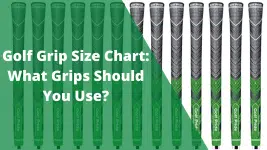Whether you’re a seasoned pro or a weekend warrior, one thing is certain: the right equipment can make all the difference. That’s where re-shafting comes in.
But what is the cost of reshafting irons? The average cost of reshafting a set of irons ranges from $200 to $450. Standard steel shafts will be cheaper, costing $15 to $30 per club, while higher-end graphite shafts cost upwards of $100 per club.
As golf re-shafting experts, we’ve seen firsthand how a well-fitted club can impact a player’s game, but you could be wasting your money if your clubs aren’t in the right condition to reshaft.
Read on to learn the cost of reshafting irons, including a breakdown of the prices, benefits, how often you should have it done, where to do it, and whether it is even worth it?
What Is Reshafting Irons In Golf?
If you’re unfamiliar with the term, “reshafting” simply means replacing the shaft on a golf club. There are a couple of reasons you’d want to do this.
- The current shaft is damaged or worn out.
- You want to experiment with different ball flights.
Whatever the reason, reshafting is a common practice among serious golfers who want to optimize their equipment for their individual needs and preferences.
When Is Reshafting Irons Worth It?
But why bother reshafting irons specifically? For starters, irons are some of the most frequently used clubs in a golfer’s bag and tend to be the most versatile.
As such, it’s necessary to have a set of irons that feels comfortable and performs consistently. Reshafting can help achieve both of those goals and more.
In fact, it’s not uncommon for golfers to experience a significant improvement in their game after getting their irons reshafted. Of course, reshafting isn’t always the best course of action. It can be costly and may not make sense if the irons are outdated or damaged beyond repair.
That said, for golfers who are serious about the game and want to get the most out of their equipment, reshafting is definitely worth considering. In the following sections, we’ll explore the benefits of reshafting irons and some factors to consider when deciding whether to take the plunge.
What’s The Cost Of Reshafting Irons?
| Factors | Costs |
| Standard Steel Shaft | $15 – $30 per club |
| Graphite Shaft | +$100 per club |
| Labor | $20 – $40 per club |
| Grip | Starting at $18 |
| Total | $200 to $450 |
Reshafting your irons can be a cost-effective way to upgrade your equipment and improve your game, but we suggest you consider the cost before deciding.
In essence, reshafting irons cost can be broken down into three main components:
- Materials
- Labor
- Grip
Materials and Quality
If you’re wondering how much to reshaft irons, one of the key factors that will impact the cost is the type of shaft you choose. Is it a uniflex shaft or a custom one?
Basically, custom shafts can be significantly more expensive than others. If you are considering a reshafting project, factor in the cost of the shaft before making a decision.
Is it expensive or cheap? And what material is it made from?
- Standard steel shaft can cost from $15 to $30 per club.
- High-end graphite shafts can cost $100 per club or above.
Now, the custom shaft iron reshaft cost may seem steep. But many golfers who have made the upgrade report significant improvements in their game, so do consider it if it doesn’t break the bank.
The Labor Aspect
Reshafting golf clubs cost due to the labor usually ranges from $20 to $40 per club, depending on the technician’s experience doing the job and where you get the work done.
For example, Golf Galaxy, a popular golf store, charges $29.99 per club for a basic steel reshafting service.
In contrast, Club Champion, a golf club fitting and building company, charges $40 per club for a basic graphite reshafting service.
The Grip
Ah, trust us, you’re almost done. The grip won’t cost you more than $18 for something like the MCC PLUS4, but it will definitely add more comfort and confidence to your shots.
So What’s The Deal?
The average cost of reshafting a set of irons ranges from $200 to $450 but can be higher if you choose a higher-end shaft or need additional work on your clubs.
This can still be a more cost-effective option than buying a brand-new set of clubs, especially if you’re satisfied with the current heads of your irons.
However, it’s important to weigh the costs and benefits of reshafting versus purchasing a new set of clubs and make a decision that aligns with your needs and budget.
Reshafting Clubs Vs. Buying New Ones—Which One’s Better?
Reshafting is a no-brainer when it comes to saving money. Would you rather spend $300 or $1000?
For instance, reshafting a set of irons with Project X NEW HZRDUS Black shafts could set you back between $200 and $300, depending on where you go and the extra work required.
Compare that to shelling out over $1000 for a new set of irons with similar shafts; the savings speak for themselves.
But let’s be real, the cost to reshaft irons can differ depending on the brand and model of the clubs you own or want to buy. Say you’re eyeing a new set of Titleist T400 irons with Project X NEW HZRDUS Black shafts – expect to fork out around $1,400 for the privilege. That’s precisely why you should know how to pick the right shaft for your driver.
However, if you choose to reshaft your existing T400 irons, you could pay only $300 to $400, depending on the retailer and the extent of the work required.
While reshafting is a more budget-friendly option, you should also consider your game’s specific needs and budget. Buying new clubs with the latest bells and whistles may be worth the investment for some golfers.
But if you’re happy with your current set and just want to improve your game, then the cost of reshafting golf clubs would be a practical solution.
How Often Should Golf Clubs Be Reshafted?
The frequency with which you should reshaft your golf clubs depends on various factors, including how often you play, how well you maintain your clubs and the types of shafts you have.
As a general rule of thumb, golfers who play frequently, such as several times a week, may need to reshaft their clubs more often than those who play infrequently, such as once or twice a month.
Another factor is how well you maintain your clubs. Clubs regularly cleaned and stored properly may not need to be reshafted as often as those neglected or abused.
In addition, the type of shaft you have can also affect how often you need to re-shaft irons. Steel shafts, for example, are generally more durable than graphite shafts and may require less frequent reshafting.
To give a more specific estimate, a golfer who plays once or twice a week and maintains their clubs well may only need to reshaft their clubs every 3-4 years. However, a golfer who plays several times a week and neglects their clubs may need to reshaft their clubs every 1-2 years.
Keep in mind that these estimates are general guidelines, and the frequency of reshafting may vary based on individual circumstances.
Steel vs. Graphite Shafts
When choosing between steel and graphite shafts, there are a few things to consider. First, let’s talk about the cost.
Generally speaking, graphite shafts tend to be more expensive than steel shafts, and so is the reshafting part. However, the shaft cost is just one factor to consider.
Steel shafts are generally known for their durability and consistency. They also tend to provide more feedback to the player, which can help improve your swing.
On the other hand, graphite shafts are the go-to choice if you’re looking for lightweight and flexibility. This can help players with slower swing speeds generate more clubhead speed and distance. Graphite shafts can also absorb more shock, which can be helpful for players with joint pain or other physical limitations.
Benefits of Reshafting Irons
Overall, reshafting your irons is a smart choice for golfers looking to upgrade their equipment without breaking the bank. With the added benefits of improved performance, personalization, and maintenance, reshafting is a worthwhile investment for any serious golfer:
Improved Performance
Upgrading the shafts of your irons can lead to a significant improvement in your overall performance on the course.
Customizable club weight and flex options allow you to tailor your clubs to your swing, increasing accuracy and distance.
With a wider range of options, golfers can also fine-tune their shots to suit their unique playing style better.
Cost-Effective
Reshafting your irons is a cost-effective alternative to purchasing a brand-new set of clubs.
With the average cost of reshafting a set of irons being significantly less than the cost of new clubs, golfers can save their investment in their existing set while enjoying upgraded equipment’s benefits.
Additionally, reshafting is a great option for those who may not have the budget to buy a new set of clubs but are still looking to improve their game.
Personalization
Reshafting also allows you to personalize your equipment to suit your style.
Choosing a new shaft material or brand allows you to customize the feel of your irons while adding custom graphics or logos can give your clubs a unique look.
This adds a personal touch to your equipment and can help you stand out on the course.
Maintenance and Repair
Reshafting is also a practical solution to fix damaged or worn-out shafts. This helps to maintain the consistency of your set and avoid the need to replace your irons entirely.
With regular maintenance and repair, you can prolong the lifespan of your clubs and keep them in top condition.
Where to Reshaft Golf Clubs
If you’re interested in reshafting your golf clubs, a few options are available.
Professional Club Fitting Shops
One option is to go to a professional club fitting shop. These shops specialize in club fitting and reshafting, and will have the equipment and expertise to ensure your new shafts are properly installed and aligned.
They may also be able to offer advice on which shafts will be best suited to your swing and playing style. Some popular professional club fitting shops include Golf Galaxy, Club Champion, and Cool Clubs.
Online Retailers
While you won’t benefit from in-person assistance, online retailers can often offer a wider selection of shafts and lower prices.
If you choose to go this route, do your research and read reviews to ensure that you’re purchasing from a reputable seller.
There are many websites around, such as Hireko Golf, GolfWorks, and Diamond Tour Golf.
Manufacturer Repair Centers
These centers will have access to the original shaft specifications and can ensure that your new shaft is properly installed and aligned.
However, it’s worth noting that this option may be more expensive than going through a club fitting shop or online retailer. Callaway Pre-Owned, TaylorMade Pre-Owned, and Titleist Custom Clubs are popular manufacturer repair centers.
Ultimately, choosing where to reshaft your golf clubs will depend on your personal preferences and needs. It’s important to consider factors such as cost, expertise, and convenience when making your decision.
FAQ
Can I Reshaft My Irons Myself?
Yes, it’s technically possible to reshaft your irons yourself. However, it’s generally only recommended if you have experience with club repair and the proper tools. Reshafting can be a complex process that requires specialized equipment, including a vice, heat gun, and epoxy.
In addition, reshafting your irons yourself can also void the manufacturer’s warranty, so it’s important to carefully consider the risks before attempting it. If you need more confidence in your ability to reshaft your clubs, it’s generally better to take them to a professional club fitter or repair center.
Can Shafts Be Repaired?
Yes, shafts can often be repaired if they’re damaged or broken. However, the extent of the damage and the type of shaft will determine whether it’s possible to repair it. In some cases, minor cracks or chips can be repaired with epoxy or similar material, while more serious damage may require a complete replacement.
Plus, repairing a shaft may not always be cost-effective, especially if the damage is severe or the shaft is old. In some cases, replacing the shaft or even the entire club may be more practical. If you’re unsure whether your damaged shaft can be repaired, it’s best to consult a professional club fitter or repair center.
How Long Does it Take to Reshaft an Iron?
The amount of time it takes to reshaft an iron can vary depending on several factors, including the complexity of the repair, the number of clubs being reshafted, and the availability of the necessary equipment and materials. In general, a single iron can be reshafted in a few hours, but if you’re reshafting an entire set of clubs, the process can take several days or even weeks.
If you’re having your clubs reshafted by a professional, it’s a good idea to ask for an estimated timeline so you can plan accordingly. Many club fitters and repair centers offer expedited service for an additional fee, so if you’re in a hurry to get your clubs back, be sure to ask about your options.
Conclusion
The cost of reshafting irons may look unnecessary at first sight, but it’s an effective way to improve your game and maintain your investment in your existing set of clubs.
You can increase your accuracy and distance on the course by customizing your club weight and flex. Plus, a bonus is the opportunity to personalize your clubs with custom graphics or logos.
While the upfront cost of reshafting may be lower, consider your investment’s overall value and longevity. Ultimately, deciding to reshaft or buy new clubs will depend on your individual circumstances and preferences.
If you decide to reshaft your clubs, find a reputable and experienced club fitting shop or repair center to ensure the best possible results. With proper maintenance and care, your reshafted clubs can continue performing at their best for many rounds.
Clint is PGA-certified and was a Head Teaching Professional at one of Toronto's busiest golf academies. He was also featured on Canada's National Golf TV program, "Score Golf Canada," twice. He graduated with a degree in Golf Management from the College of the Desert in California and studied under Callaway's co-founder, Tony Manzoni.
He has a handicap index of 6.2 and spends the winters near Oaxaca, Mexico, where he plays twice a month at the Club de Golf Vista Hermosa. He's written over 100 articles at GolfSpan since 2021. You can connect with Clint at LinkedIn, FB, his website, or Clintcpga@gmail.com.
- Best score: 68
- Favorite club: Odyssey White Hot Two-Ball Center-Shafted Putter
- Favorite ball: Titleist Pro V1x
- Favorite food at the turn: Hot dog









